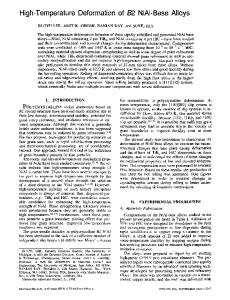Creep Deformation Mechanisms in Ru-Ni-Al Ternary B2 Alloys
- PDF / 721,262 Bytes
- 11 Pages / 593.972 x 792 pts Page_size
- 103 Downloads / 481 Views
INTRODUCTION
THE need for enhanced turbine engine efficiency continues to drive the development of materials that can tolerate increasingly higher turbine inlet temperatures. Ordered B2 aluminides have emerged as a promising class of materials for high-temperature structural or coating applications, because they are generally stable over a wide composition range, have high melting points, high strength, relatively low densities, and good oxidation and corrosion resistance.[1–5] B2 RuAl compounds have received considerable development impetus due to their good combination of ductility, strength, and thermodynamic stability. Despite having a melting temperature about 400 K higher than its B2 counterpart NiAl, RuAl has lower rate sensitivity,[3,6] higher toughness, and compressional ductility.[7] RuAl also exhibits characteristics of better intrinsic deformability at low temperature and has a greater number of active slip systems than NiAl.[3,7,8] Due to the superior physical properties of RuAl over NiAl, addition of Ru to NiAl is of particular interest for improving the high-temperature capabilities of the conventional NiAl-based bond coats in superalloythermal barrier coating systems (TBCs) for advanced gas turbine engines.[4,9] Fabrication approaches for multilayered Ru-modified bond coats for TBCs have been successfully demonstrated.[9] Additionally, RuAl has a lower coefficient of thermal expansion (CTE) than the traditional Pt-modified NiAl bond coat layers.[10] Evaluation of the mechanical response of multilayer TBC coatings via finite element analysis has shown that increasing the bond coat creep strength would suppress the plastic deformation driven by thermal expansion F. CAO, Postdoctoral Researcher, is with Structure/Property Relations, Materials Science and Technology (MST-8), Los Alamos National Laboratory, Los Alamos, NM 87545, USA. Contact email: [email protected] T.M. POLLOCK, Professor, is with the Department of Materials Science and Engineering, University of Michigan, Ann Arbor, MI 48109, USA. Manuscript submitted May 24, 2007. Article published online November 21, 2007 METALLURGICAL AND MATERIALS TRANSACTIONS A
mismatch that results in rumpling and failure of the TBCs,[11] thus extending the useful life of the TBC systems. A continuous B2 phase has been shown to exist across the Ru-Ni-Al ternary between the RuAl and NiAl phases at temperatures of 1273 and 1373 K.[12] Moreover, our preliminary investigations identified greatly improved creep properties of Ru-Ni-Al ternary B2 alloys with increasing ruthenium content.[4] However, detailed analysis of creep behavior and operative creep mechanisms in this ternary system have not yet been addressed. An understanding of the deformation and creep mechanisms across the Ru-Ni-Al B2 field is essential for tailoring the Ru-modified bond coats for TBCs and for understanding their performance within these multilayered systems. In the present study, a detailed investigation of the creep behavior was carried out on five Ru-Ni-Al ternary alloys with compositions within the NiA
Data Loading...











